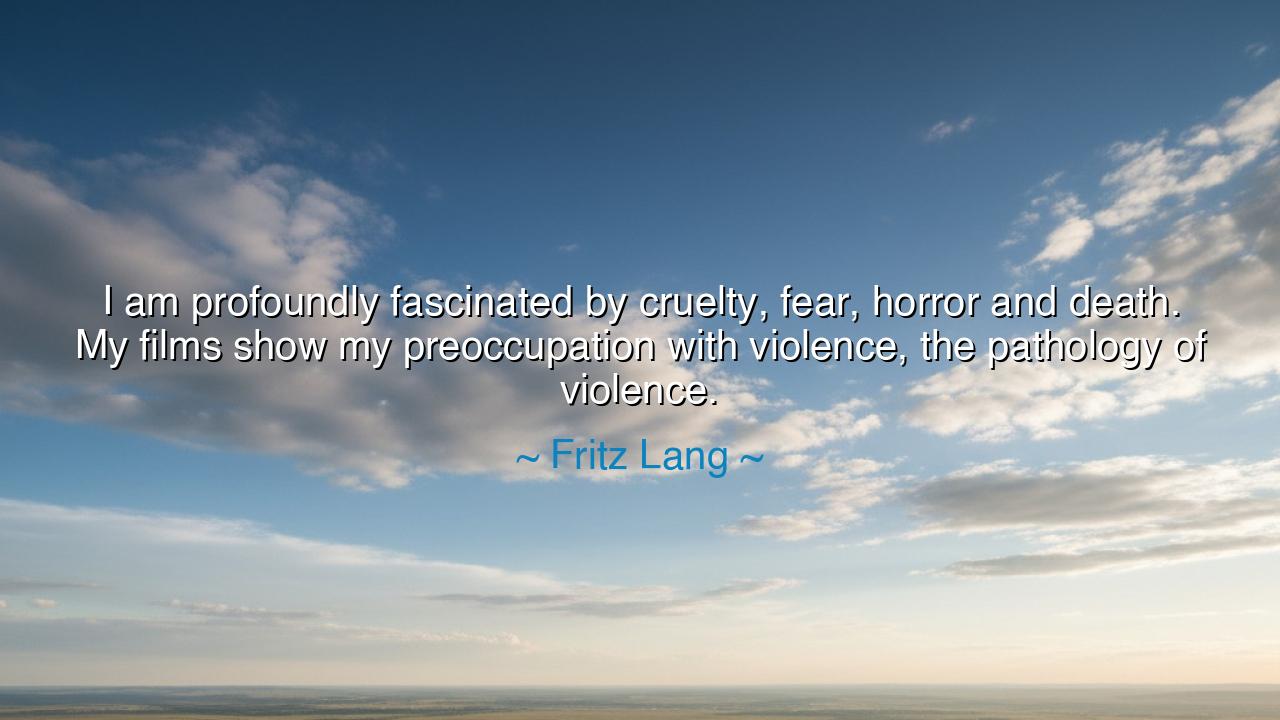
I am profoundly fascinated by cruelty, fear, horror and death. My
I am profoundly fascinated by cruelty, fear, horror and death. My films show my preoccupation with violence, the pathology of violence.






“I am profoundly fascinated by cruelty, fear, horror, and death. My films show my preoccupation with violence, the pathology of violence.” — thus spoke Fritz Lang, the master of shadows and mirrors, whose eyes peered into the abyss of the human soul and refused to look away. In these words lies not the confession of a man drawn to evil, but the testimony of one who dared to study it. For Lang understood a truth that many flee from — that cruelty, fear, and death are not strangers to the human heart, but its hidden kin. To understand them is to understand ourselves.
Lang was a storyteller of darkness, yet within his darkness there was always a search for light. Born in the chaos of a century that had devoured itself in war and tyranny, he witnessed how ordinary men became monsters under the spell of ideology and fear. From these wounds was born his obsession with violence — not to glorify it, but to dissect it, to lay bare its pathology, the sickness that festers when conscience dies and power reigns. His films were not mere entertainments but mirrors — mirrors that forced humankind to face its reflection without the veil of illusion.
The ancients, too, understood this grim fascination. In the tragedies of Aeschylus and Sophocles, gods and kings met ruin through pride and cruelty; in the stories of Heracles and Orestes, violence was both curse and inheritance. These were not tales to delight the heart, but to awaken the soul. Lang walked in their footsteps. Like them, he knew that to portray horror truthfully is to reveal the boundaries of good and evil — to warn, to teach, and to humble. Thus, the artist who paints darkness does not serve it; he seeks to conquer it through understanding.
Consider the tale of Goya, the painter who lived through the nightmare of war in Spain. Once a court artist of beauty and grace, he turned his brush upon the horrors of humanity — massacres, madness, and despair. His series The Disasters of War depicts bodies torn apart, faces twisted in terror, and the cruelty of men against men. Yet Goya did not paint to indulge in violence; he painted to testify. Like Lang, he declared: “This is what we are capable of — behold it, and tremble.” Such artists carry the burden of truth upon their shoulders, so that others may awaken before it is too late.
Lang’s preoccupation with violence was, in truth, a meditation on moral decay. In his masterpiece M, the murderer who preys upon children is not merely a villain — he is a reflection of the society that hunts him, a world poisoned by hysteria and judgment. The line between the hunter and the hunted blurs, and the audience is left uneasy, uncertain who among them is more corrupt. In this, Lang becomes a philosopher of film, showing that evil is not an external demon but a seed in every human heart. His fascination was not with blood, but with conscience — the trembling line between order and chaos, between civilization and the abyss.
To the modern soul, these words may seem unsettling. We live in an age that hides from its own darkness — that seeks comfort and distraction rather than reflection. Yet to deny cruelty is to allow it to grow unseen. Lang’s wisdom reminds us that the only way to banish shadows is to shine light upon them. To understand fear is to rob it of power; to acknowledge death is to cherish life more fiercely. The artist, the thinker, and the seeker must dare to look into the depths — not to be consumed by them, but to learn what must never be repeated.
Thus, the lesson is this: Do not turn away from the darkness within or without. Confront it. Study it. Transform it. For only those who have faced horror can truly build peace. Let every man and woman become a mirror — honest, unflinching — in which truth is reflected without distortion. In your own life, look upon your fears and cruelties not with shame, but with the courage to change them. Name the monster, and it will lose its hold upon you.
And so, let the teaching of Fritz Lang endure: to be fascinated by fear and death is not to love them, but to seek mastery over them. Through art, through wisdom, through truth, the human spirit may yet rise above the violence that made it tremble. For it is not in blindness but in awareness that redemption is found — and only those who dare to walk through shadow can bring back the light.






AAdministratorAdministrator
Welcome, honored guests. Please leave a comment, we will respond soon